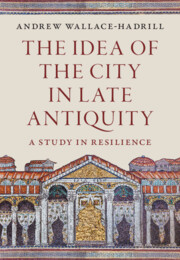Book contents
- The Idea of the City in Late Antiquity
- Praise for The Idea of the City in Late Antiquity
- The Idea of the City in Late Antiquity
- Copyright page
- Dedication
- Contents
- Figures
- Preface
- 1 The End of the Ancient City?
- 2 In Praise of the City
- 3 The City in Question
- 4 The City Revived?
- 5 The City Embattled
- 6 The City and Its Records
- 7 The City of Bishops
- 8 The Grammar of the City
- 9 The Fabric of the City
- 10 Decline and Resilience
- Bibliography
- Index
1 - The End of the Ancient City?
Published online by Cambridge University Press: 30 January 2025
- The Idea of the City in Late Antiquity
- Praise for The Idea of the City in Late Antiquity
- The Idea of the City in Late Antiquity
- Copyright page
- Dedication
- Contents
- Figures
- Preface
- 1 The End of the Ancient City?
- 2 In Praise of the City
- 3 The City in Question
- 4 The City Revived?
- 5 The City Embattled
- 6 The City and Its Records
- 7 The City of Bishops
- 8 The Grammar of the City
- 9 The Fabric of the City
- 10 Decline and Resilience
- Bibliography
- Index
Summary
Chapter 1 raises the question of whether there was a decisive break in the nature of the city between Classical Antiquity and the post-Roman world of Late Antiquity and the Early Middle Ages. It is suggested that treating ‘the ancient city’ as typologically different from cities before or after obscures both the real degree of continuity and the perceptions of contemporaries of continuity. The chapter explores the historiography of the idea of the ancient city as a distinct type that goes back to Fustel de Coulanges, and has been identified by different schools of thought as religious, economic, political, and physical. Rather than thinking of ‘decline and fall’, or even ‘transformation’, a new approach is offered through resilience theory, that sees a continuous process of drawing on memories of the past and, through them, adaptation.
- Type
- Chapter
- Information
- The Idea of the City in Late AntiquityA Study in Resilience, pp. 1 - 32Publisher: Cambridge University PressPrint publication year: 2025

